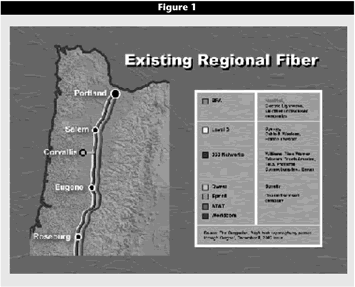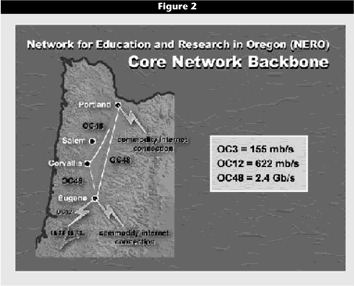Oregon State University’s demand for bandwidth to support scientific collaboration and research continues to grow exponentially, while state funding declines due to hard economic times. Our challenge is to find creative yet fiscally responsible ways to meet OSU’s bandwidth demands. Looking at our options for high-capacity bandwidth to the commodity Internet and Internet2, we hit upon just such a creative solution—we partnered with a data service provider to build our own regional dark fiber network.
A Little Background
First, we should provide a little background on how OSU is connected to the Internet and Internet2 today and what the traditional options for connectivity looked like when we began. OSU, located in Corvallis, Oregon, is a member of the Network for Education and Research in Oregon (NERO) consortium, which connects all higher education institutions in the state to each other, to the commodity Internet, and to Internet2 (see Figure 1). Out-of-state connections are made either at the Oregon Internet Exchange in Eugene (run by our colleagues at the University of Oregon) or at the Pittock Internet Exchange in Portland. Of the two Internet exchanges, the Pittock has more options because virtually all major fiber-optic cable in the state connects there. Also, the Pittock is a physical fiber hub for national and international fiber runs.

Click image for larger view.
When we began our inquiries into higher bandwidth connections, we contacted the traditional telecommunications carriers to price a circuit to the Pittock from OSU. For a circuit that would give us speeds in excess of a gigabit per second (an OC48), we were quoted as much as $564,000 a month! That would cost OSU more than $6 million annually, meaning that our overall central IT budget would need to increase by 50 percent. Obviously, this approach was not feasible given our tight funding.
We decided to explore other approaches, thinking we might leverage our existing partnerships or create new ones to address our problem in a more creative way. We learned that NERO had acquired access to dark fiber installed by Level 3 Communications from Eugene to Portland, landing in the Pittock Internet Exchange. For OSU, this dark-fiber access held fantastic potential, but it was just out of reach: that fiber path lay 20 miles to the east of us. Our challenge was how to get the 20 miles of connecting fiber built and managed.
Old Friends, New Partnerships
In the spring of 2002, Ben Doty stopped in for a visit and to talk about his new venture, NoaNet Oregon. Curt Pederson and Doty knew each other from Doty’s days with the Central Lincoln Public Utility District in Newport, Oregon. Before coming to OSU, Pederson—as the CIO for the State of Oregon—had struck up a friendship with Doty while working on last-mile connectivity issues throughout the state.
Doty thought Pederson might be interested in having OSU partner with NoaNet somehow. NoaNet is a 503.c.12 nonprofit cooperative that builds and operates "public purpose" data networks. It uses Bonneville Power Administration (BPA) long-haul fiber in the Northwest to bring metropolitan data carrier services to rural Oregon and Washington. As a nonprofit cooperative, its culture and values were very much in line with those of OSU. A partnership seemed natural. Pederson introduced Doty to Shay Dakan, OSU Director of Network Services, and suggested that the two talk.
The nearest BPA fiber point-of-presence (POP) was also 20 miles to the east, in the same Interstate 5 corridor where the NERO consortium had fiber. NoaNet was looking for a way to build fiber to Corvallis and service the local area.
Originally intended as just a friendly visit, this conversation soon led to serious discussions regarding how OSU and NoaNet might work together on the build-out of fiber. Doty felt that NoaNet had the utility experience to build and run fiber, but not the capital budget to construct the 20-mile route needed; Dakan felt that OSU could afford a one-time capital-improvements expense but did not want to manage the fiber facility. A deal was struck, and a partnership was born. Dakan asked her Data Services Manager, Jon Dolan, to draft a contract and work out the details with NoaNet.
The basics of the deal follow:
- OSU pays for the build-out and owns the 20 miles of fiber.
- NoaNet Oregon constructs and manages the fiber plant.
- NoaNet leases excess fiber from OSU as an Indefeasible Right to Use1 (IRU).
- The lease fee is 10 percent of revenue generated by NoaNet Oregon from its use of the plant.
Money and Politics
As it turned out, finding the money for the project was the easiest part. We commissioned an engineering firm specializing in telecommunications infrastructure to do a feasibility study. They estimated that the entire build-out cost for the most direct route would be $315,000. Compared to paying commercial carrier fees, this is a bargain basement price. We budgeted $500,000 out of general funds for the one-time build-out, with the goal of realizing $60,000 a year in revenue from our 10 percent share. Even if we made nothing, not having to pay the traditional telecommunications carrier fees more than justified the initial investment. With our senior university administration enthusiastically behind us, we were ready to move forward.
Before we could sign a contract and start placing fiber, however, we needed to make sure that the partnership we envisioned was legal. We spoke with our contracts office, our legal counsel, the State Department of Administrative Services, the State Department of Justice, the Oregon University System, local municipalities, and local utilities. Because the arrangement differed from "normal" telecommunications contracts, many of those entities requested extensive review and discussion. In fact, putting together the contract took more than 12 months. Ultimately, we earned enthusiastic support and approval for this innovative approach.
We were surprised by where our toughest hurdles came from. The organizations we thought would be the easiest to work with turned out to present the most challenges for us. In retrospect, we were guilty of assuming support from our local city officials, thinking they would see this as a great opportunity for not only the university but the community at large. As it turned out, it took quite a bit of work with the City of Corvallis to find an arrangement that works for both of us. The city had concerns regarding right-of-way access, primarily because Corvallis relies on permits and franchise fees to cover approximately 26 percent of its general fund. We were able, finally, to settle on a standard franchise agreement with the city that entitled Corvallis to 7 percent of our earnings.
Following this experience, we can recommend key points to getting everyone on board:
- Understand the financial stake of each player.
- Start discussions early because they will take time.
- Pay close attention to right-of-way issues with cities and utilities.
The Result
The end result of building our fiber link is that OSU has dramatically and immediately increased our off-campus bandwidth. In addition, we have future options that simply would not have been available had we gone with the standard commercial telecommunications providers. We strengthened our existing partnerships by connecting to the fiber operated by our regional networking consortium and formed a new partnership allowing us to connect to others throughout the Northwest (see Figure 2).

Click image for larger view.
We can summarize our progress and benefits as follows:
- OSU connects to both NoaNet Oregon- and NERO-run fiber.
- OSU and NERO are able to immediately build an OC48 ring among all major research universities in the state, with the ability to increase it as needed.
- NoaNet provides OSU with new networking options, such as being able to connect directly to the Pacific Northwest National Labs in southwest Washington.
- OSU has other opportunities to increase connection speeds through NoaNet to satellite facilities statewide, such as our extension offices, our agricultural experiment stations, our new campus in Bend, Oregon, and our Hatfield Marine Science Center in Newport, Oregon.
As we look to future Internet2 directions, we also feel that we are very strongly placed for whatever might happen on a national scale.
In addition to benefiting OSU, our project has served as a model of cooperation for the local K–12 schools, city governments, and county governments. Those entities have each installed their own sections of fiber in the local area. After talking with us and each other, they have agreed to work on how they might use their fiber to build a common network. Such a public-purpose network would allow them to provide higher data rates and much better data services to firehouses, libraries, and schools in our local communities without a huge taxpayer investment.
We can summarize the key factors for success of our project as follows:
- Trust. NoaNet and OSU built the relationship and wrote the contract on the premise that we were true partners and would succeed, or fail, together.
- Cultural values. As a nonprofit cooperative, NoaNet shared the university’s community service values.
- Relationships, relationships, relationships. This fiber build-out project all started with a handshake and a conversation about how to help each other.
In closing, we cannot stress enough the value of relationships and building them early. Where we had good existing relationships, things went very well; where new ones were needed, we had obstacles to overcome. In hindsight, this process would have been much easier if we already had been working with the City of Corvallis and other local governments on networking issues and had clearly understood their needs in the beginning. Start those relationships now!
